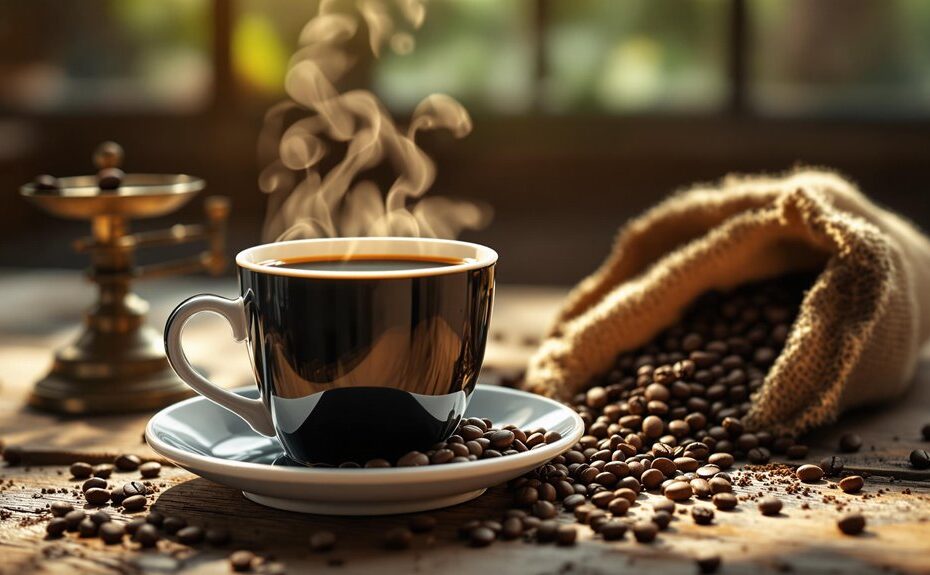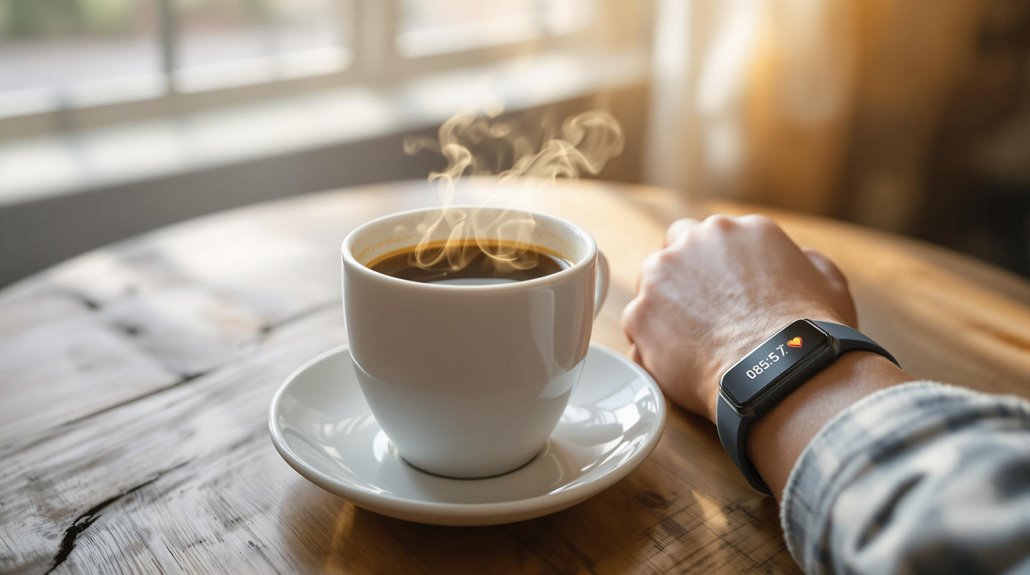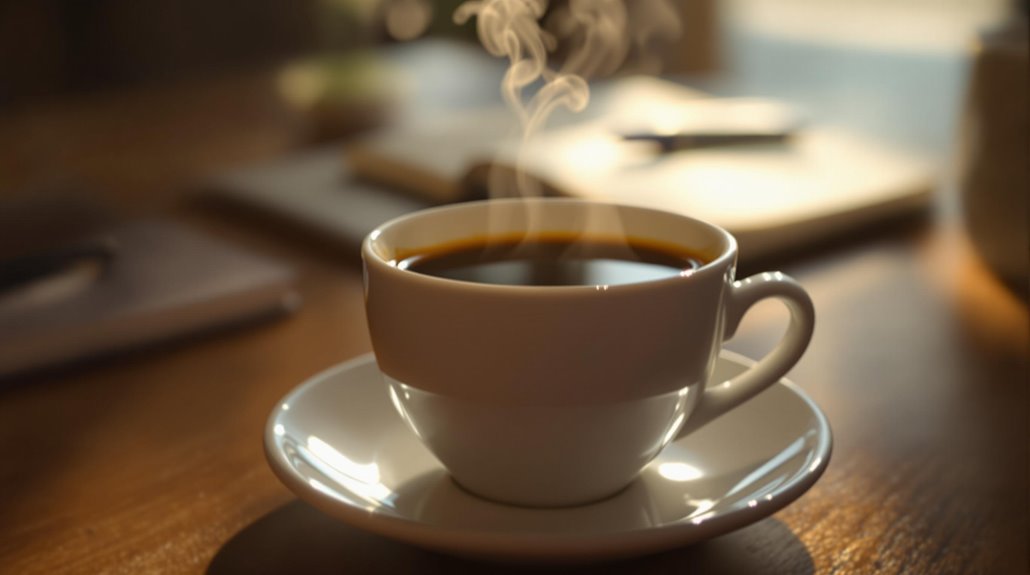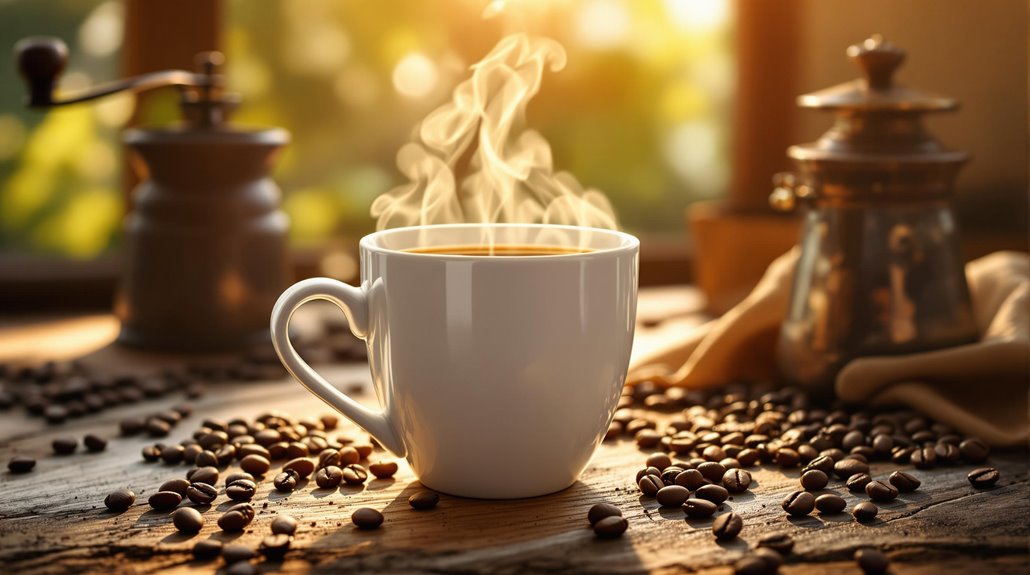







Did you know an average 8-ounce cup of brewed coffee contains about 150.5 mg of caffeine, but that number can swing wildly depending on how it's made? You might think you're getting a consistent dose with every sip, but factors like bean type, roast level, and brewing method can drastically alter what ends up in your mug. Even decaf isn't entirely caffeine-free. If you've ever wondered why one cup leaves you buzzing while another barely perks you up, the answer lies in the details—details that might surprise you.
Key Takeaways
- An 8-ounce cup of brewed coffee contains 95-200 mg of caffeine, with an average of 150.5 mg.
- A single shot of espresso (1 oz) has 63 mg of caffeine, while a double shot (2 oz) contains 125-154 mg.
- Instant coffee provides 27-173 mg of caffeine per 8-ounce serving, averaging 57.1 mg in a 6-ounce cup.
- Decaf coffee contains 2-15 mg of caffeine per 8-ounce cup, with about 97% of caffeine removed during processing.
- Caffeine content varies based on bean type, roast level, brewing method, grind size, and serving size.
Caffeine Content in Brewed Coffee
When it comes to brewed coffee, the caffeine content can vary widely depending on several factors. A standard 8-ounce cup of brewed coffee typically contains between 95 to 200 milligrams (mg) of caffeine, while a 12-ounce cup ranges from 113 to 247 mg. On average, you'll find about 150.5 mg of caffeine per cup. However, these numbers aren't fixed—they depend on the type of beans, the roast level, and the brewing method. For example, lighter roasts often retain more caffeine than darker roasts because prolonged roasting breaks down caffeine molecules. The brewing process also plays a role; longer extraction times or finer grinds can increase caffeine content. Commercial brands like Starbucks and Dunkin Donuts often have higher caffeine levels, with a Starbucks grande (16 ounces) containing 330 mg and a Dunkin Donuts medium (14 ounces) offering 210 mg. If you're curious about how much caffeine you're consuming, pay attention to the beans and brewing technique, as these factors greatly influence the final caffeine content in your cup.
Espresso and Espresso-Based Drinks

Espresso packs a concentrated caffeine punch, with a single shot (1 ounce) containing about 63 mg and a double shot (2 ounces) delivering around 125 mg. Espresso-based drinks like lattes and cappuccinos typically match the caffeine content of the espresso shots they're made with, so a 12-ounce latte with a double shot provides roughly 125 mg. While espresso has a higher caffeine concentration per ounce than brewed coffee, its smaller serving size means you'll often consume less caffeine overall unless you opt for multiple shots.
Espresso Caffeine Concentration
A single shot of espresso, typically around 2 ounces, packs an average of 108.3 mg of caffeine, though it can reach up to 127 mg. This caffeine concentration is higher per ounce compared to most coffee beverages, with one ounce of espresso containing about 63 mg of caffeine. However, due to its smaller serving size, the total caffeine per shot is less than what you'd find in a standard cup of drip coffee. A double shot, which doubles the serving size to about 4 ounces, contains roughly 200 to 300 mg of caffeine, depending on the beans and brewing method. Espresso-based drinks like lattes and cappuccinos maintain the same caffeine content as straight espresso, as they're made with one or two shots. The key difference lies in the caffeine concentration per volume, which is higher in espresso but distributed across a smaller serving size. Whether you're sipping a single shot or enjoying a double shot, the caffeine content remains consistent per shot, making espresso a potent yet compact option for caffeine seekers.
Double Shot Espresso Content
A double shot of espresso delivers a concentrated caffeine boost, typically containing 200 to 300 mg of caffeine depending on the beans and brewing method. This amount is extracted from 14-18 grams of finely ground coffee beans, which are tightly packed and subjected to high pressure as hot water is forced through them. The result is a 2-ounce (oz) serving with an average caffeine content of 154 mg. While the caffeine concentration per ounce is higher than brewed coffee, the total caffeine in a double shot of espresso is often less due to its smaller serving size. Espresso-based drinks, such as lattes or cappuccinos, use this double shot as their base, meaning they also contain around 154 mg of caffeine per 12-ounce serving. The precise milligrams of caffeine can vary based on factors like the type of coffee beans, roast level, and extraction time. If you're seeking a quick, potent caffeine hit, a double shot of espresso is an efficient choice compared to larger volumes of brewed coffee.
Espresso-Based Drink Variations
When exploring espresso-based drinks, you'll find that their caffeine content is primarily determined by the number of espresso shots used, not the added ingredients. A single shot of espresso (1 ounce) contains about 63 mg of caffeine, while a double shot (2 ounces) has around 125 mg. Popular espresso-based drinks like lattes and cappuccinos typically use one or two shots, meaning their caffeine content matches that of straight espresso. For example, a standard 12-ounce cappuccino or latte usually contains about 154 mg of caffeine, derived from two shots of espresso. Despite the addition of milk, foam, or flavorings, the caffeine concentration in these drinks remains unchanged, as these ingredients don't affect the espresso's caffeine content. Espresso has a higher caffeine concentration per ounce (63 mg) compared to brewed coffee (12-16 mg per ounce), but its smaller serving sizes result in less total caffeine per drink. Whether you're sipping a latte, cappuccino, or straight espresso, the caffeine per drink depends on the number of shots, not the volume or type of additives.
Instant Coffee Caffeine Levels
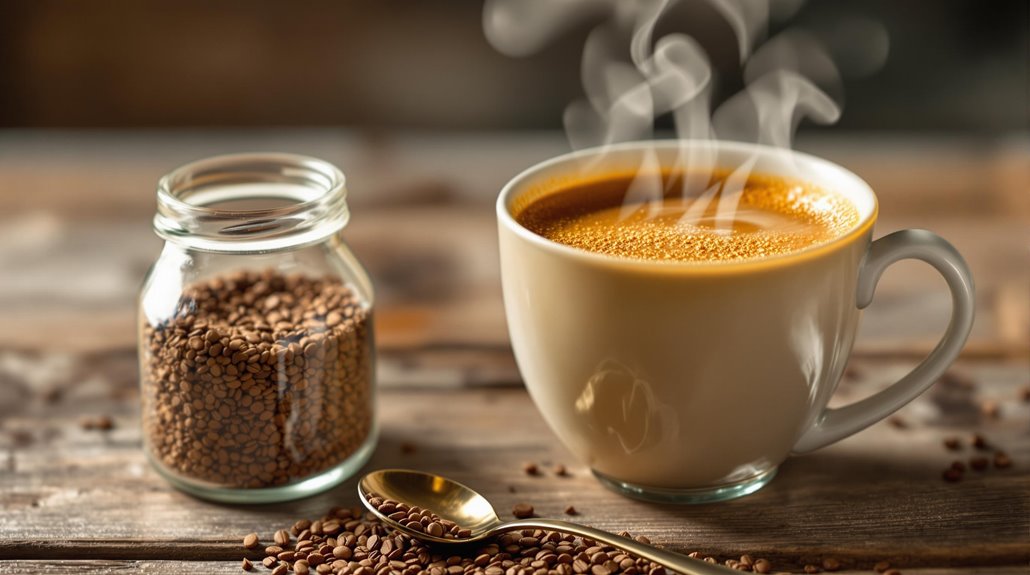
Instant coffee typically contains 27 to 173 mg of caffeine per 8-ounce serving, with an average of 57.1 mg in a 6-ounce cup. This makes it a lower-caffeine option compared to brewed coffee, which often has higher concentrations due to its extraction process. The caffeine content can vary slightly depending on the brand and how you prepare it, but instant coffee remains a convenient choice for those seeking a milder caffeine boost.
Instant Coffee Caffeine Range
Instant coffee's caffeine content typically ranges from 27 to 173 mg per 8-ounce serving, making it a lower-caffeine option compared to brewed coffee. The caffeine range in instant coffee depends on factors like the brand and preparation method. Most instant coffee is made from freeze-dried or spray-dried brewed coffee, which reduces its caffeine content during processing. On average, a 6-ounce cup contains about 45 mg of caffeine, with some brands offering slightly higher or lower amounts. This variability means you might consume anywhere from 30 to 90 mg of caffeine in a typical serving, depending on the product and how much you use. If you're looking for a lower-caffeine alternative to brewed coffee, instant coffee fits the bill, as it generally contains less caffeine per serving. However, keep in mind that the exact caffeine content can vary, so check the label if you're monitoring your intake. Whether you prefer freeze-dried or spray-dried instant coffee, you can expect a milder caffeine boost compared to traditional brewing methods.
Brewing Vs Instant Comparison
If you're comparing caffeine levels, instant coffee generally packs less punch than brewed coffee. A typical serving of instant coffee contains 30-90 mg of caffeine, while brewed coffee ranges from 95-200 mg per serving. For example, a 6-ounce cup of instant coffee averages around 57.1 mg of caffeine, noticeably lower than the caffeine content in a similar serving of brewed coffee. This difference stems from the preparation method: instant coffee is made from freeze-dried or spray-dried brewed coffee, which reduces its caffeine concentration compared to freshly brewed coffee. While the exact mg of caffeine in instant coffee can vary slightly by brand, it consistently offers a lower caffeine option. If you prefer a milder caffeine boost or value convenience, instant coffee provides a quick and easy alternative. However, if you're seeking a stronger caffeine kick, brewed coffee is the better choice. Understanding these differences helps you decide which preparation method aligns with your caffeine needs and lifestyle.
Decaf Coffee: How Much Caffeine?
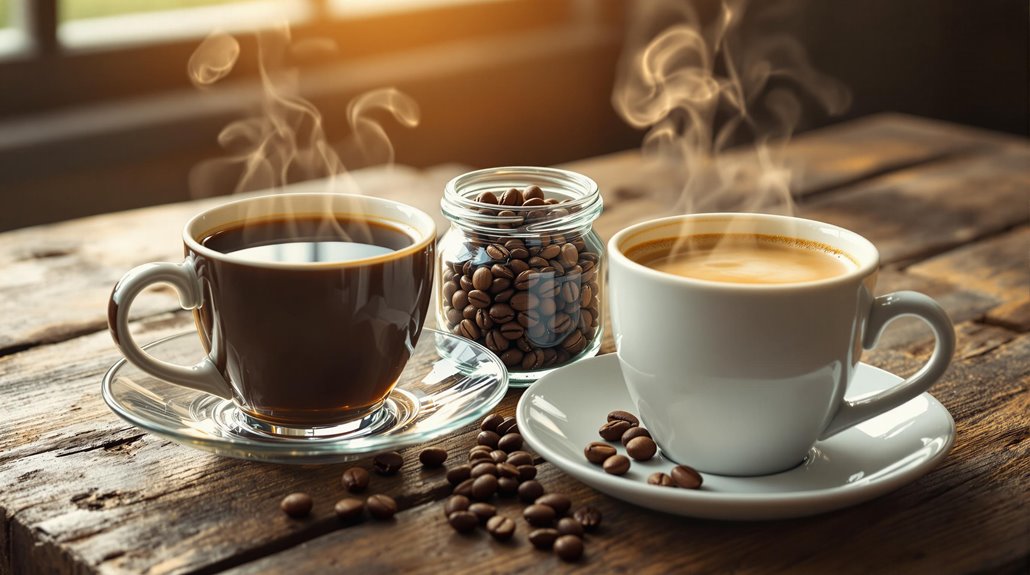
Decaf coffee often contains a small amount of caffeine, typically ranging from 2 to 15 mg per 8-ounce cup, though this can vary slightly depending on the brand. While the decaffeination process removes about 97% of the caffeine from coffee beans, trace amounts remain, meaning decaf coffee isn't entirely caffeine-free. A standard serving of decaf coffee typically contains less than 5% of the caffeine found in regular coffee, making it a better option for those sensitive to caffeine. However, the exact amount of caffeine in your cup depends on factors like the type of coffee bean, the brewing method, and the serving size. For example, a 12-ounce cup of decaf coffee from Starbucks contains approximately 20 mg of caffeine, slightly higher than the average. If you're monitoring your caffeine intake, remember that even decaf coffee contains some caffeine, so adjust your consumption accordingly. While it's a low-caffeine alternative, it's not entirely devoid of it, so choose your serving size and brewing method wisely to suit your needs.
Factors Influencing Caffeine Content
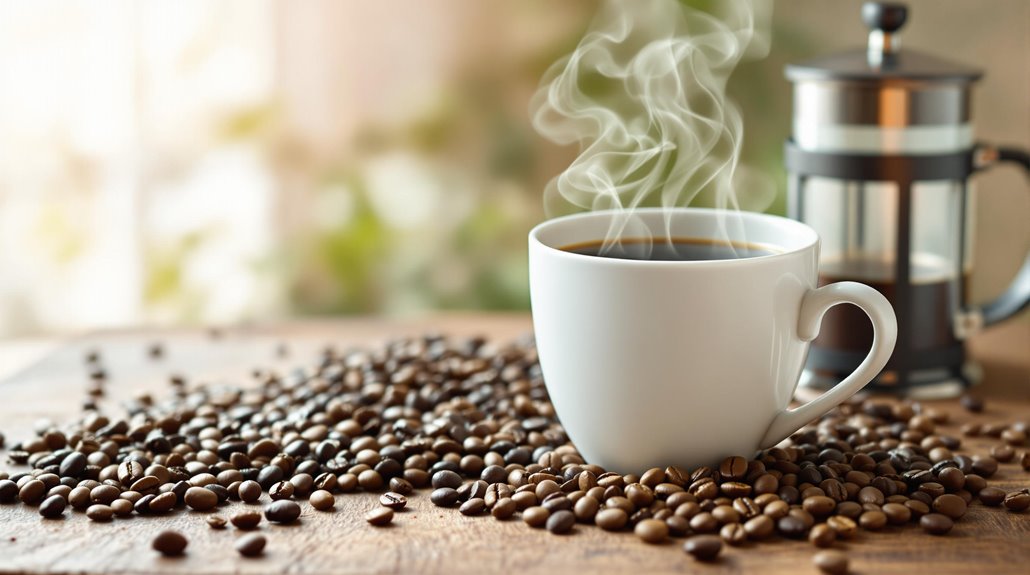
Several factors can influence how much caffeine ends up in your cup of coffee. The type of coffee beans you use plays a significant role; Robusta beans contain nearly double the caffeine of Arabica beans. Roast level, however, doesn't drastically alter caffeine levels, though darker roasts may seem less caffeinated due to lower bean density. Brewing time and method also affect caffeine levels—espresso, for example, has a higher concentration per ounce than drip coffee because of its shorter extraction time and finer grind size. Grind size itself impacts caffeine extraction; finer grinds release more caffeine during brewing. Additionally, the serving size directly determines your total caffeine intake—larger cups naturally contain more caffeine than smaller ones. These factors affect caffeine levels in your coffee, so understanding them helps you tailor your brew to your preferences. Whether you're choosing between types of coffee or adjusting your grind size, these variables guarantee you can control how much caffeine you consume.
Health Benefits of Coffee Consumption
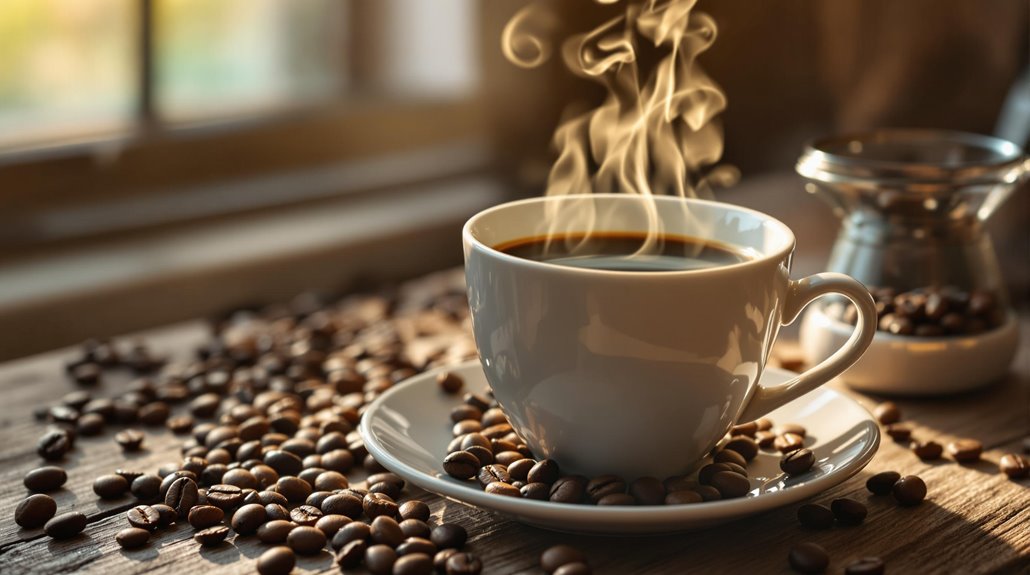
Regularly enjoying coffee can offer a range of health benefits backed by scientific research. Moderate coffee consumption is linked to a lower risk of chronic diseases, including type 2 diabetes, with studies showing a 23-50% reduction in risk. Coffee is rich in antioxidants, which help reduce inflammation and combat oxidative stress, contributing to overall health. These compounds may also protect against heart disease and stroke, with regular drinkers experiencing a 15% lower risk of heart disease and a 20% reduced risk of stroke. Additionally, coffee consumption has been associated with a lower risk of neurodegenerative diseases like Alzheimer's and Parkinson's, potentially reducing the likelihood by up to 65%. The antioxidants and caffeine in coffee may also support brain function and mood. Research suggests that drinking coffee can lower the risk of depression by 10-15%, likely due to its stimulant effects on the central nervous system. By incorporating coffee into your routine, you're not just enjoying a beverage—you're potentially supporting long-term health.
Recommended Daily Caffeine Limits
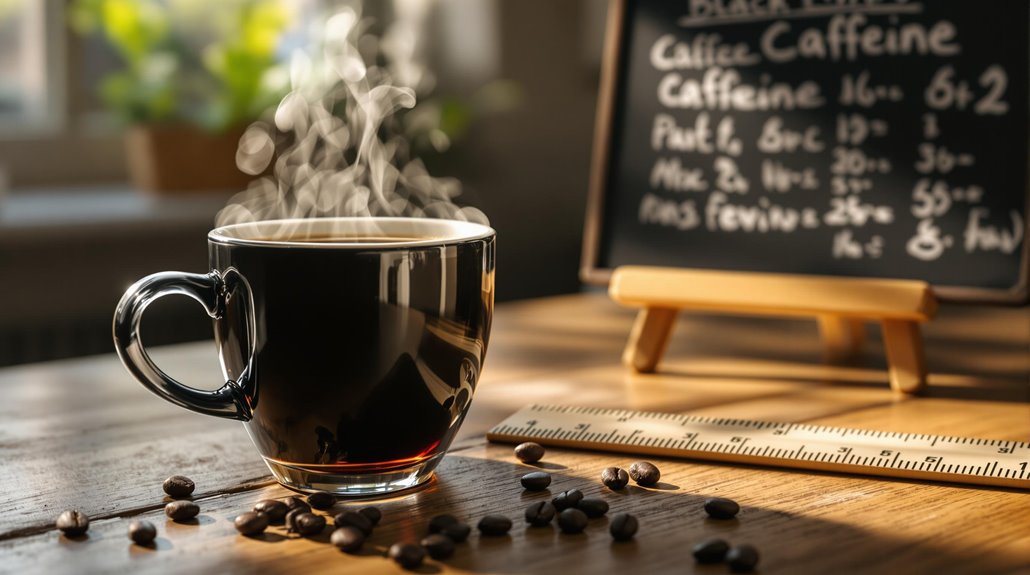
Understanding your daily caffeine limits is key to enjoying coffee safely and effectively. For healthy adults, the FDA recommends a maximum caffeine intake of 400 mg per day, roughly equivalent to three to four cups of coffee. Staying within this limit helps you avoid potential adverse effects like insomnia, jitters, or an elevated heart rate. However, caffeine sensitivity varies, so you may need to adjust your intake based on how your body responds. Pregnant women, on the other hand, should limit their caffeine consumption to 200 mg daily to reduce risks to the developing fetus. Exceeding these guidelines can lead to side effects, especially if you're sensitive to caffeine or have underlying health conditions. Children and individuals with cardiac arrhythmias are generally advised to avoid or substantially limit caffeine intake. By monitoring your mg caffeine consumption and understanding the effects of caffeine consumption, you can enjoy your coffee while minimizing risks. Always consider your personal tolerance and health status to determine the right balance for you.
Managing Caffeine Intake Effectively

To manage your caffeine intake effectively, start by tracking how much you consume daily to guarantee it aligns with the FDA's recommended limit of 400 mg for healthy adults. Pay attention to the amount of coffee you use, as brewing methods and serving sizes can substantially affect the caffeine content. For example, a standard 8-ounce cup of brewed coffee contains about 95 mg, but larger servings at coffee shops can exceed 200 mg per drink. If you're drinking coffee frequently, consider switching to decaf or half-caf options, which contain only 2-15 mg per cup, to reduce your overall caffeine consumption in healthy adults. Avoid caffeine at least 6 hours before bedtime to prevent sleep disruption and insomnia. If you're looking to cut back, do so gradually to avoid withdrawal symptoms like headaches or fatigue. When ordering coffee drinks at a coffee shop, ask about caffeine levels or check labels if available, as specialty drinks often contain more caffeine than standard brews. By staying informed and mindful, you can enjoy coffee without overdoing it.
Disclosure: As an Amazon Associate, I earn from qualifying purchases.
